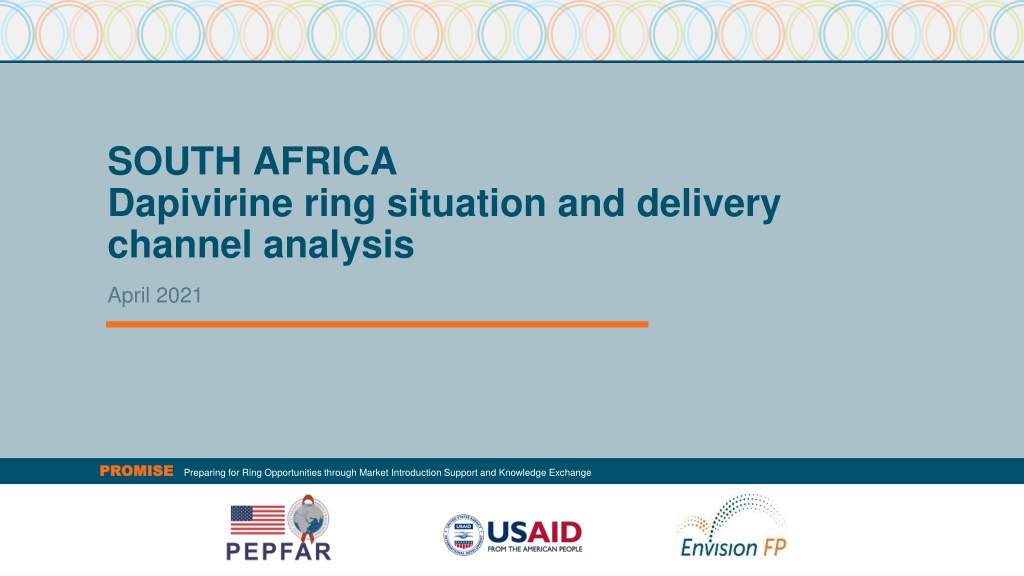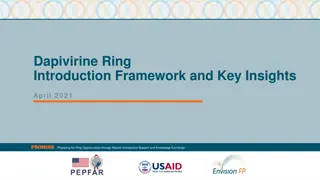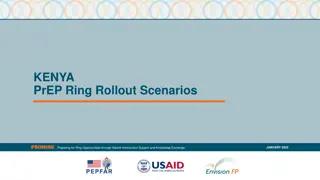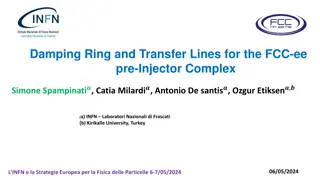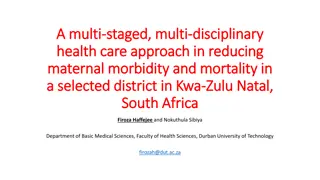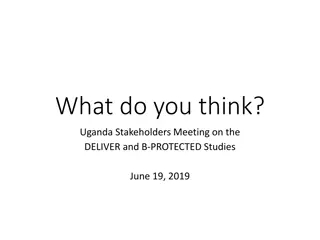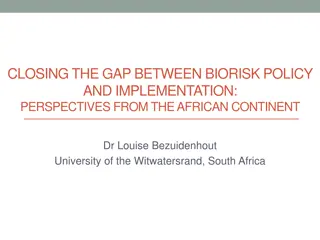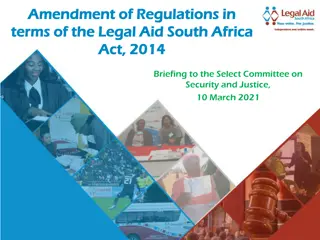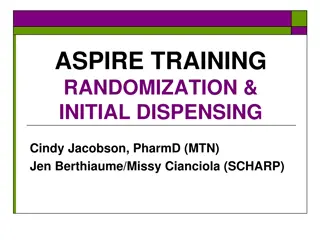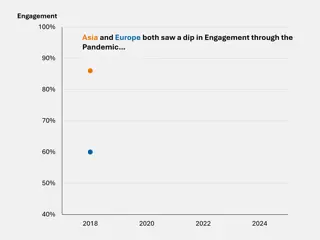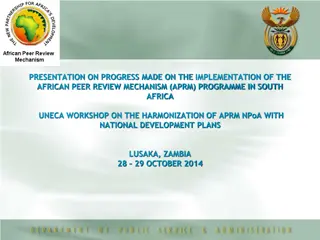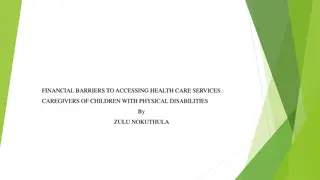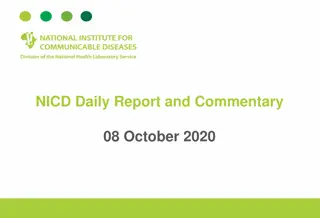Analysis of Dapivirine Ring Introduction in South Africa
South Africa's potential introduction of the dapivirine ring for HIV prevention is analyzed, highlighting key stakeholder recognition, delivery channels, and planning considerations. Leveraging lessons from oral PrEP rollout, the analysis aims to support policymakers and implementers in integrating the ring effectively. Key questions on enthusiasm and uptake, regulatory scheduling, and leveraging existing infrastructure are addressed.
Download Presentation

Please find below an Image/Link to download the presentation.
The content on the website is provided AS IS for your information and personal use only. It may not be sold, licensed, or shared on other websites without obtaining consent from the author. Download presentation by click this link. If you encounter any issues during the download, it is possible that the publisher has removed the file from their server.
E N D
Presentation Transcript
SOUTH AFRICA Dapivirine ring situation and delivery channel analysis April 2021 PROMISE PROMISE Preparing for Ring Opportunities through Market Introduction Support and Knowledge Exchange
Introduction This analysis can support introduction of the dapivirine ring (the ring) in South Africa across two dimensions: - Considering and prioritizing delivery channels for the ring - Identifying critical steps for ring introduction, including opportunities to build on the introduction and scale-up of oral PrEP This analysis is based on several inputs including secondary research and interviews with key stakeholders in South Africa This analysis can be used by policymakers, implementers, and others planning for introduction of the ring and other biomedical HIV prevention methods in South Africa This analysis was developed in late 2020 and early 2021 by members of the PROMISE collaboration through Envision FP Similar analyses for several other countries and a summary of results across countries will be available on PrEPWatch.org
Key findings As a woman-controlled and long-acting HIV prevention option, key stakeholders recognize that the dapivirine ring (the ring) can be an important addition to the HIV prevention portfolio in South Africa. South Africa has had a relatively large-scale rollout of oral PrEP, which has established systems and yielded lessons for policy development, planning, supply chain, provider training, demand creation, and monitoring that can be leveraged for introduction of the ring. The scale-up of oral PrEP is ongoing and provides an opportunity to integrate the ring for initial rollout. A key concern for policymakers and other key stakeholders is the extent to which there will be enthusiasm for and uptake of a vaginally-inserted product with partial efficacy this will be a key question to test in early rollout of the ring. A range of delivery channels will help the ring reach women at substantial risk for HIV, including public primary health care clinics, private sector providers and pharmacies, nongovernmental organization (NGO) clinics, and ongoing NGO programs for adolescent girls and young women (AGYW). A key outstanding question is how the ring will be scheduled by regulatory authorities, which will have significant implications for where and how the ring can be delivered. (Note that this analysis was conducted prior to the completion of regulatory review by the South African Health Products Regulatory Authority [SAHPRA]).
Context for the dapivirine ring Delivery channels for the dapivirine ring Dapivirine ring introduction planning Sources
Context South Africa has the world s largest HIV epidemic South Africa has the world s largest HIV epidemic, with an estimated 7.6 million people living with HIV in 2019. The country s HIV prevalence remains high, with one in five people living with HIV. The country also has the largest HIV treatment program in the world, which has largely been financed from its own domestic resources. Overview of HIV prevention and treatment response The increase in national life expectancy from 56 years in 2010 to 63 years in 2018 demonstrates the success of South Africa s HIV treatment program. The country is also progressing on its 90-90-90 targets, specifically related to testing and viral suppression. Overview of HIV incidence and prevalence in South Africa South Africa has an estimated 7.6 million people living with HIV, with a prevalence of 20.4% and 201,000 annual new infections. Trends in new HIV infections, 2019 Progress towards 90-90-90 Sources: Avert; Thembisa 4.3 Provincial Model Results 2019 (University of Cape Town, 2020), UNAIDS HIV Data and Estimates (2020)
Context HIV prevalence is high across South Africa While HIV prevalence is high across the country, it is particularly high in several provinces, including KwaZulu-Natal, Mpumalanga, and Free State, although KwaZulu-Natal, Gauteng, and Eastern Cape experience the highest levels of new HIV infections. HIV prevalence by province, 2019 New HIV infections by province, 2019 Northern Cape 2% Free State 5% Limpopo 10.8% Western Cape Gauteng 12.4% 7% Gauteng 26% North West Mpumalanga 16.0% 8% North West 13.9% Free State 15.1% KwaZulu-Natal 18.0% Limpopo 8% Northern Cape 9.8% KwaZulu-Natal 21% Mpumalanga Eastern Cape 13.5% 9% Western Cape 7.5% Eastern Cape 14% Source: Thembisa 4.3 Provincial Model Results 2019 (University of Cape Town, 2020)
Context Young women and FSW remain at substantial risk for HIV Women, especially young women and female sex workers (FSW) are disproportionately affected by HIV. New HIV infections by age and gender, 2019 140,000 Across all age groups, estimates suggest that 26% of South African women are living with HIV compared to 15% of South African men, and that women of all age groups have higher HIV incidence rates than men. 120,000 100,000 FSW have the highest HIV risk, with prevalence over 50% and incidence over 5%. 80,000 60,000 AGYW aged 15 24 account for 30% of the 201,000 new HIV infections each year in people over the age of 15. AGYW have an HIV incidence rate over 4 times that of their male peers (1.3% vs. 0.3%). 40,000 20,000 Gender inequity, gender-based violence (GBV), and poverty contribute to these disparities. 0 Male Female Age 15 - 24 Age 25 - 49 Age 50+ Source: Let Our Actions Count: Reflections on NSP 2012 2016 and moving forward to NSP 2017 2022
South Africa was an early adopter of oral PrEP and is continuing scale-up South Africa was the first country in sub-Saharan Africa to approve oral PrEP, doing so in December 2015. The country continues to scale up oral PrEP throughout its public and private health systems today. PrEP Initiations South Africa has a goal to reduce new HIV infections to less than 100,000 new infections per year by 2022. 2016 While oral PrEP was initially provided to FSW and men who have sex with men. It was then expanded to AGYW, based at funded sites and clinics, universities and colleges and is now being scaled up in all ~3,456 public primary health care clinics across 52 districts and 9 provinces. Facilities are being prioritized according to impact and population reach, although scale-up has been slowed due to COVID-19. 2017 Today, most oral PrEP initiators in South Africa are AGYW and the country has exceeded its initial targets; however, stakeholders recognize challenges to continuation. 2018 2019 South Africa has also invested significantly in national demand creation campaigns and platforms to support uptake by women and girls, for example the MyPrEP and B-Wise websites and social media. 2020 0 25,000 50,000 75,000 AGYW Others Source: OPTIONS Final Report (FHI 360, 2020)
The dapivirine ring could be an important HIV prevention choice for women Key findings from stakeholder consultations As a woman-controlled and long-acting HIV prevention option, the ring is an important addition to the HIV prevention portfolio in South Africa. The portfolio of HIV prevention options is starting to look more like family planning (FP) and should be treated that way, to ensure greater access to more choices, especially for AGYW. The ring may be particularly appropriate for AGYW, who are at substantial risk for HIV, but often have challenges advocating for condom use, prefer not to take a daily pill, and/or want to avoid oral PrEP side effects; however, as noted by stakeholders, the clinical data suggest that women >21 years are more likely to use the ring, raising questions of ring acceptability among AGYW. There is significant opportunity to build from the experience with oral PrEP to introduce the ring; for example, the ring can build on the current oral PrEP technical working group (TWG) and related policies, plans, and provider training. The ring will be considered as an additional HIV prevention option together with oral PrEP as and when South African regulatory approval is attained. Key national stakeholders recognize the opportunity to introduce the ring alongside the scale-up of oral PrEP
Context for the dapivirine ring Delivery channels for the dapivirine ring Dapivirine ring introduction planning Sources
Delivery Channels Potential delivery channels for the ring South Africa delivers health services through a large public sector health system, which serves ~84% of the population, as well as a significant private sector, which services ~16% of the population. Description Women s health delivery channels Public sector primary healthcare facilities managed by the National Department of Health (NDOH), provincial and district governments offering a range of sexual and reproductive health (SRH) services, including HIV testing and treatment, oral PrEP, FP, and antenatal care/postnatal care (ANC/PNC), although often specific services are offered on different days or through different departments Public sector health services Public sector Facility-based and mobile services that reach specific populations (e.g., FSW, AGYW), managed by the NDOH in partnership with implementing partners and focused on hotspots Population-focused programs Facility-based and mobile health services offered at higher education institutions, including universities and technical (TVET) colleges, that reach young women Higher education health services Private for Private for-profit healthcare that largely serves individuals with health insurance, including hospital groups (e.g., Netcare, Life Healthcare, Mediclinic) and smaller practices and individual clinicians Private clinics or providers profit Private pharmacies include several large corporate chains (e.g., Dis-Chem, Clicks), as well as independent community pharmacies (some are members of the Independent Community Pharmacy Association), typically staffed by a trained pharmacist and sometimes also staffed with a trained nurse Corporate & community pharmacies Private not for profit Private not-for-profit clinics managed by NGOs offering subsidized health services; major networks dedicated to SRH include PSI, MSI, Society for Family Health, and Unjani Clinics Nonprofit clinic chains
Delivery Channels Delivery channels differ by access and capacity Delivery channels were assessed along six criteria: three assessing the channel s reach to women at-risk for HIV and three assessing the channel s capacity to deliver the ring. The following slides include details on the assessment findings. Assessment criteria CAPACITY: What capacity is already in place to support ring delivery? ACCESS: To what extent does this channel reach women at-risk of HIV? 2 1 Factor Definition Factor Definition HIV counseling and testing services (HTS) Channel currently offers HIV counseling and testing services. Channel provides SRH services for women and girls vulnerable to HIV. Reach Healthcare worker (HCW) capacity Services provided through this channel are affordable for women and girls vulnerable to HIV with a range of income levels. Channel has HCW on-staff who can initiate ring use and support follow-up. Affordability Other products that are relevant to women and girls vulnerable to HIV (e.g., HIV testing, oral PrEP, FP) are offered through this channel. Channel has private space for women to initiate and insert ring for the first time. Product portfolio Private space Rating key Channel reaches high numbers of women at-risk for HIV Sites consistently have infrastructure, capacity needed to deliver the ring Channel reaches some segments of women at-risk for HIV Some sites have the infrastructure, capacity needed to deliver the ring Sites rarely have the infrastructure, capacity needed to deliver the ring Channel does not reach many women at-risk for HIV
Delivery Channels Delivery channel access assessment 1 Product portfolio HTS PrEP Reach Affordability FP Majority of women (~85%) receive HTS from public clinics Majority of women (~80%) receive FP from public clinics, including 95% of those using injectables, 94% of those receiving implants, and 77% of those using contraceptive pills 4,200 public health clinics across the country Scale- up in 2021 Public sector health services Services are provided for free Sex worker programs reach ~35K 40K women with an aim to reach 70K women PEPFAR-funded DREAMS sites focused on AGYW are expanding from 5 districts to 24 districts; the program has been effective in reducing rates of HIV among AGYW at pilot sites Scale- up in 2021 Population-focused programs Services are provided for free National strategic plan for HIV recognizes schools and universities as critical environments to reach AGYW with SRH services via a low stigma delivery point Includes 26 universities and 50 TVET colleges that reach ~650K young women (~4% of women aged 15 49) Higher education health services Services are provided for free Unaffordable for the 83% of the population without insurance, due to high cost of products and services Contraception costs USD 6 25 per month and oral PrEP costs USD 23 per month (including labs) Both are increasingly covered by health insurance 6% of women receive FP from private clinics and providers Largely serve the 17% of the population that is covered by medical insurance Predominantly in urban areas, with 188 urban and 50 rural hospitals nearly half of private hospitals are in Gauteng Province Private clinics and providers 12% of women receive FP from pharmacies Services delivered via ~3,000 sites across South Africa, with greater availability in urban areas Attract a range of customers, across income levels A new national NDOH program is delivering medicines for chronic diseases through pharmacies HIV self-testing (HIVST) is an average of USD 7 15 per test Stakeholders suggest USD 3.50 5/ring would be a reasonable price Public-private partnerships vary by province, but have been tested to deliver free commodities (e.g., for FP, chronic conditions) through community pharmacies Corporate & community pharmacies Several relatively small networks, however, they often have greater reach in rural areas (e.g., New Start clinics have over 150K visits annually with 87% in rural areas, Unjani clinics have ~450K visits annually in peri-urban and semi-rural areas) Provide subsidies or use a tiered pricing model to ensure services are affordable for low- and middle-income women Nonprofit clinic chains
Delivery Channels Delivery channel capacity assessment 2 HTS HCW capacity Private space Healthcare workers are well trained and credentialed However, HCWs typically have little time to counsel patients, which can make introducing new products challenging Facility-based services typically offered in a private space Community-based and mobile services strive to provide private spaces in temporary structures Public sector health services Testing is available in all public sector facilities, however it is not always offered consistently across services Testing is available across these services, however it is not always offered consistently across services 13% of HIV tests are delivered in specialty centers, such as youth centers Typically managed by professional nurses, some with Nurse Initiated and Managed Antiretroviral Treatment (NIMART) training Population-focused programs Services typically offered in a private space Universities and colleges have on-site health centers that provide HIV testing and FP services University campaigns typically test ~200,000 people a year for HIV Universities and colleges typically refer patients to health facilities to receive antiretroviral therapy (ART) Universities have more capacity, while TVETs can be rural and under-resourced Higher education health services Services typically offered in a private space High capacity, as commercial facilities are multispecialty centers in which women can receive a wide range of services Private hospitals and providers have advanced structures to support follow up and manage care by on- site specialists and pharmacists Private clinics and providers 17% of South Africans receive HTS from a private facility Services typically offered in a private space Some pharmacies have nurses on staff in addition to pharmacists Pharmacy nurses can deliver FP and are increasingly able to initiate ART as they receive NIMART training Pharmacies increasingly offer HIV self-testing ~20% of pharmacies offer on-site HIV testing and counseling via nurses Corporate & community pharmacies Some pharmacies have private or semi-private rooms Social franchises have deep expertise and experience in providing HTS services as part of comprehensive SRH Social franchises typically emphasize judgment-free service delivery Services typically offered in a private space NGO social franchises
Delivery Channels Prioritizing delivery channels for the ring Delivery channel prioritization Bringing together the access and capacity dimensions allows us to assess delivery channels against both criteria High access, low capacity > Channels for information & referrals High access, high capacity > Priority for ring delivery The channels in the upper right corner have both high capacity to deliver the ring and high access to women and AGYW at high risk for HIV who would benefit from the ring Public sector health clinics Corporate & community pharmacies Population-focused programs Higher education health services NGO social franchises Channels in the upper left have less capacity to deliver the ring, but have high access to high-risk populations Access assessment Private clinics or providers Channels in the lower right have less access to high-risk, HIV-negative populations but have high capacity to deliver the ring Low access, low capacity > Deprioritize for ring delivery Low access, high capacity > Lower priority for ring delivery Channels in the lower left have neither the capacity nor reach to effectively deliver the ring Capacity assessment
Delivery Channels Priority delivery channels for the ring High priority channels for the ring A range of delivery channels could be relevant for the ring to reach different population segments: First priority: Public sector clinics and population-focused programs have the best reach to women and girls at substantial risk for HIV and high capacity to effectively deliver the ring. However, there is significant variation within public sector channels. Integration with FP services, community-based/outreach services, and adolescent-friendly services will be particularly relevant for the ring. Second priority: Post-secondary education health services have strong HIV prevention programs and have a wide reach throughout the country, including in rural areas, and could provide a good channel to reach younger women. Third priority: Pharmacies are also a possible channel for ring distribution, depending on the regulatory classification of the ring. This would be particularly helpful in positioning the ring as a complement to oral PrEP, which cannot be initiated in pharmacies. In addition, nonprofit clinics also have good reach to women and AGYW in urban, peri-urban, and rural areas, with highly trained staff and the capacity to effectively deliver the ring. Fourth priority: Private providers reach fewer women than the public sector, however they still reach a significant number of women for FP and HIV testing services. In addition, stakeholders noted that introducing products only in the public sector could lead to misperceptions of product inferiority and urged introduction of the ring in private, as well as public, channels.
Context for the dapivirine ring Delivery channels for the dapivirine ring Dapivirine ring introduction planning Sources
Ring Introduction Ring introduction framework This value chain framework has been used across countries to support planning for oral PrEP introduction. It has been adapted for the ring to identify necessary steps for ring introduction and scale-up across five major categories and across priority delivery channels. It can also be used to track progress towards ring introduction by different partners. Value Chain for Dapivirine Ring PLANNING & BUDGETING SUPPLY CHAIN MANAGEMENT RING DELIVERY PLATFORMS UPTAKE & EFFECTIVE USE MONITORING National and county plans are established to implement dapivirine ring guidelines for priority end user populations Dapivirine ring is available and distributed in sufficient quantity to meet projected demand via priority delivery channels Dapivirine ring is delivered by trained healthcare workers in priority delivery channels to effectively reach end users End users know about and understand the ring and are able to seek, initiate, and effectively use the ring The ring is effectively integrated into national, provincial, district, sub- district, facility, and program level monitoring systems
Ring Introduction South Africa ring introduction situation analysis This framework highlights critical elements of ring introduction and assesses the current state across these elements in South Africa. PLANNING & BUDGETING SUPPLY CHAIN MANAGEMENT UPTAKE & EFFECTIVE USE DELIVERY MONITORING Convene new or existing technical working group/ subcommittee for the ring Register the ring and include the ring on the national essential medicines list Issue standard clinical guidelines for delivery and use of the ring Develop and implement demand creation strategies that include ring promotion Establishmonitoring tools to support data collection and analysis on ring use Update supply chain guidelines and logistics systems to include the ring Dedicate resources to conduct regular HIV tests, initiate ring use, and support refills Address social norms/stigma to build community and partner acceptance of ring use Establish systems for pharmacovigilanceand to monitor drug resistance Identify target populations for ring use Engage community stakeholders to inform planning for ring rollout Establish monitoring, demand forecasting, and distribution systems to avoid stock-outs Develop materials and conduct trainings for health care workers on the ring Develop information and tools for clients to guide product choice and support ring use Conduct implementation science research to inform policy and scale-up Develop impact, cost and/or cost-effectivenessanalyses to inform ring planning Establish referral systems to link clients from other channels to sites dispensing the ring Support adherence and continuation for ring users Include the ring in national HIV prevention and other relevant plans (e.g., FP) Develop and communicate plans for sanitary disposal of used rings Integrate support for partner communication and intimate partner violence (IPV) Developimplementation plan and budget to guide initial ring introduction and scale-up COLOR KEY Anticipate easy integration with oral PrEP Will require new effort, but no anticipated challenges An area that will require significant consideration
Ring Introduction South Africa situation analysis summary findings Summary findings from the South Africa situation analysis are below, with details included on the following slides. PLANNING & BUDGETING SUPPLY CHAIN MANAGEMENT UPTAKE & EFFECTIVE USE DELIVERY MONITORING An existing PrEP TWG will likely guide introduction of the ring Scheduling for the ring will determine how and where it can be delivered (e.g., whether it will require a clinician prescription, can be provided by a pharmacist, or can be purchased directly) South Africa has a range of models to deliver SRH services (e.g., mobile sites, community-based services), but oral PrEP has largely been delivered in clinical settings via NIMART-trained nurses A number of existing platforms can support demand creation activities and messages for the ring, including B-Wise and myPrEP.co.za Delivery of oral PrEP is monitored at the facility- level, with overall management from the NDOH the ring will likely be added to this system and set of tools Inclusion of the ring in the South Africa HIV prevention investment case will be key to informing policy decisions These platforms can also provide information and support decision-making around PrEP options The public sector supply chain is managed by the NDOH, while private sector providers and pharmacies procure commodities from private, registered wholesalers The NDOH is considering a phased rollout of the ring, with defined implementation science questions to guide early learning to inform broader scale-up South Africa is scaling up oral PrEP in 2021, which offers an opportunity to integrate the ring alongside initial introduction of oral PrEP in some regions As such, the ring may require development of new delivery models building on, but not limited to, models used for oral PrEP A major outstanding question is how end users will respond to the ring uptake of the contraceptive ring has been low since being made available South Africa also has ongoing efforts to train HCWs on oral PrEP, established referral networks for oral PrEP, and screening for IPV as part of the oral PrEP package all of which provide a strong foundation for the ring Policymakers expect the ring will be a niche product and are considering how to introduce it alongside other HIV prevention options A new initiative to deliver public sector commodities for treatment of chronic conditions via pharmacies may offer an opportunity for delivery of the ring In addition, sustaining demand creation efforts has been challenging due to lack of resources Financing for oral PrEP has been a mix of domestic and donor resources
PLANNING & BUDGETING Planning & budgeting key steps What is needed to introduce the ring Relevant Stakeholders Considerations The PrEP TWG continues to work on scale-up of oral PrEP and HIV self- testing Convene new or existing technical working group/ subcommittee for the ring Current PrEP TWG will likely guide introduction of the ring South Africa already has a PrEP TWG and AGYW TWG Oral PrEP was initially targeted to key populations, which created stigma for broader rollout; stakeholders recognize the need to make the ring available to the general population Key stakeholders expect that the ring will be a niche product, particularly useful for those who cannot effectively use oral PrEP Identify target populations for ring use NDOH HIV Department NDOH SRH Department PrEP TWG AGYW TWG South African National AIDS Council (SANAC) Provincial Departments of Health CHAI HE2RO (investment case) Community engagement is critical, as some faith-based and community groups have pushed back against PrEP provision, especially for AGYW Participants from ring trials could support engagement activities as ring ambassadors The ring should be integrated into the Health Economics and Epidemiology Research Office (HE2RO) investment case for HIV prevention The investment case analysis is conducted across HIV prevention interventions and will estimate the impact and compare cost-effectiveness of different HIV prevention interventions The ring should be added to a range of relevant policies and plans, including: the National Strategic Plan for HIV, TB and STIs (to be revised in 2022); the South Africa National Sex Worker HIV Plan; and the National Policy on HIV PrEP and Test and Treat (last updated in 2016) Engage community stakeholders to inform planning for ring rollout Stakeholders recognize that long- acting injectable cabotegravir (CAB- LA) should also be added to the investment case update Develop impact, cost and/or cost-effectivenessanalyses to inform ring planning South Africa is currently developing a National Health Insurance plan, which could integrate the ring A key question for initial rollout will be to test the extent of interest in the ring, which will guide further scale-up An outstanding question is the cost of ring delivery Include the ring in national HIV prevention and other relevant policies and plans The ring will likely be integrated into the ongoing effort to scale up oral PrEP, which has been delayed due to COVID-19 PrEP rollout has largely been financed by domestic resources, outside of initial research or demonstration projects and some AGYW-focused programming NDOH CHAI Donors: PEPFAR, UNITAID, Global Fund Developimplementation plan and budget to guide initial ring introduction and scale-up Text in blue indicates key steps related to diverse delivery channels
SUPPLY CHAIN MANAGEMENT Supply chain management key steps What is needed to introduce the ring SAHPRA approval will be needed for the ring In the approval, SAHPRA scheduling for the ring will determine how and where the ring can be delivered: it can be made freely available in retail channels, including pharmacies (Schedule 1), require provision by a pharmacist (Schedule 2), or require a clinician prescription (Schedule 3 or 4) After approval from SAHPRA, the ring needs to be endorsed by the National Health Council based on evidence, the investment case, and recommendations from the NDOH To be added to the Essentials Medicines List, the ring will need to be approved by the Affordable Medicines Directorate and have demonstrated evidence of demand, feasibility, and cost-effectiveness; the Essential Medicines List will next be updated in 2023 2024 Procurement and logistics systems are managed centrally by NDOH CHAI is currently supporting the NDOH to update supply chain guidelines and logistics systems Pharmacies and social franchises procure commodities from accredited wholesale distributors (e.g., DSB, Alpha Pharm) For pharmacies, a recent program to deliver chronic disease medications to users via pharmacies for free (Central Chronic Medicine Dispensing) may be an effective program to consider for oral PrEP and the ring Relevant Stakeholders Considerations Scheduling for the ring will be critical to enable delivery in a diverse range of channels there has been a trend towards re-scheduling or allowing permits that enable greater access to SRH products in particular SAHPRA National Health Council NDOH Affordable Medicine Directorate Register the ring and include the ring on the national essential medicines list NDOH Province Departments of Health Provincial Medical Procurement Units (PMPUs) CHAI Update supply chain guidelines and logistics systems to include the ring There have been challenges with stock- outs for oral PrEP and FP products There have also been challenges with unused stocks when implementation did not generate sufficient demand (e.g., sub-dermal contraceptive implant) The ring can be integrated into current commodity tracking programs for PrEP/HIV prevention programs, which aggregate stock reporting from PrEP sites on a monthly basis Establish monitoring, demand forecasting, and distribution systems to avoid stock-outs NDOH Text in blue indicates key steps related to diverse delivery channels
DELIVERY PLATFORMS Ring delivery platforms key steps What is needed to introduce the ring The ring will need to be integrated into the existing guidelines, i.e., South African Guidelines for the Provision of PrEP to Persons at Substantial Risk of HIV Infection (last updated in 2020) While the ring can be readily integrated into HIV services, integrating the ring with FP or other SRH services will require service integration this is currently uneven across South African provinces In addition, identifying opportunities to deliver the ring outside of clinical settings can build on South Africa s diverse set of delivery channels, but will require new models from oral PrEP, which has largely been delivered in clinical settings by NIMART-trained nurses Training for the ring can be integrated into a 1.5-hour online training for oral PrEP and other tools that exist for PrEP (e.g., job aids) for use by NIMART- trained nurses Initial training materials for oral PrEP were developed by the South African HIV Clinicians Society NDOH is currently developing a training curriculum for an SRH nurse to provide integrated services the training will be rolled out nationally and is currently being piloted in Limpopo and Gauteng, and is a good opportunity to integrate the ring Private sector providers and pharmacists are reliant on continuing medical education (CME) and medical detailing via pharmaceutical companies to learn about and engage with new products There are a range of referral mechanisms that are being used for oral PrEP that could also support delivery of the ring, including referrals from HIV testing sites, community partners, social media, and tools like PrEP Finder Relevant Stakeholders NDoH South African HIV Clinicians Society Considerations Issue standard clinical guidelines for delivery and use of the ring An outstanding question is what frequency of HIV testing will be required for ring users and whether HIV self-tests could be used with the ring (HIVST is not currently used for oral PrEP) Dedicate resources to conduct regular HIV tests, initiate ring use, and support refills NDoH South African HIV Clinicians Society South African Medical Association (for private providers) Higher Health (for universities and colleges) Provider attitudes remain a challenge, especially toward providing oral PrEP to AGYW Providers will need to understand and accept the lower efficacy of the ring Develop materials and conduct trainings for health care workers on the ring Establish referral systems to link clients from other channels to sites dispensing the ring Screening for IPV is part of the oral PrEP delivery package and is included in guidelines for HIV prevention services Integrate support for partner communication and IPV Text in blue indicates key steps related to diverse delivery channels
UPTAKE AND EFFECTIVE USE Uptake and effective use key steps What is needed to introduce the ring Relevant Stakeholders Considerations Research suggests that there is low awareness of and demand for oral PrEP, especially among AGYW The contraceptive ring is currently available in South Africa, but has not seen significant uptake Develop and implement demand creation strategies that include ring promotion Formative research to confirm barriers and facilitators of ring uptake will be helpful National PrEP demand creation strategies and programs will need to be updated to include all forms of PrEP, including the ring and CAB-LA NDOH, SANAC, and all partners rendering SRH and HIV services National PrEP demand creation strategies may need to be updated to include specific activities to address social norms, stigma, and partner support Existing community and partner engagement activities for oral PrEP will need to be updated to include discussion of the ring as an additional PrEP option The HIV Prevention Ambassadors training and implementation tools will need to be updated to include the ring NDOH, SANAC, and all partners rendering SRH and HIV services Address social norms/stigma to build community and partner acceptance of ring use Resources are needed to sustain effective #endstigma communication campaigns Apply updated national PrEP demand creation strategies to guide the development of appropriate tools and materials to capacitate and motivate clients to use the ring Existing platforms, such as B-Wise, She Conquers, and MyPrEP.co.za offer an opportunity to build awareness of and access to the ring and help potential users understand and make decisions between different HIV prevention options Develop information and tools for clients to guide product choice and support ring use NDOH, Wits Reproductive Health and HIV Institute (Wits RHI), and B-Wise Resources are needed for digital and print communication campaigns NDOH and all partners rendering SRH and HIV services Resources to sustain awareness campaigns beyond initial rollout have been limited for oral PrEP Healthcare worker training should be focused not only on clinical skills, but also on how to provide empathetic, client-centered adherence support Support adherence and continuation for ring users Client education activities, materials, and tools will need to include discussion of proper ring disposal Provider training tools and materials should include ring disposal information Develop and communicate plans for sanitary disposal of used rings Resources to rolloutcommunication to all sites NDOH guidelines
MONITORING Monitoring key steps What is needed to introduce the ring Relevant Stakeholders Considerations Reporting and tracking for oral PrEP currently conducted at the facility level, reporting up into the NDOH Targets are set at the clinic level based on population demographics in the catchment area The ring can be integrated into these monitoring and evaluation (M&E) systems Establishmonitoring tools to support data collection and analysis on ring use NDOH Establish systems for pharmacovigilanceand to monitor drug resistance SAHPRA PrEP TWG National pharmacovigilance procedures are in place, overseen by SAHPRA For the ring, the NDoH is aiming to have a more country-led process for ring introduction and early learning than existed for oral PrEP, where multiple projects were conducted without coordination with NDoH NDoH is planning for a phased rollout of the ring Conduct implementation science research to inform policy and scale-up NDoH PrEP TWG
Context for the dapivirine ring Delivery channels for the dapivirine ring Dapivirine ring introduction planning Sources
Interview list The following organizations were consulted in the development of this analysis: National Department of Health Wits RHI South African Association of Obstetricians and Gynecologists Aloe Pharmacy USAID Global Health Supply Chain Program Higher Health Ibis Reproductive Health
Select desk review sources Sources Let Our Actions Count: South Africa s National Strategic Plan for HIV, TB, and STIs 2017 2022, South Africa National Department of Health, 2017 Let Our Actions Count: Reflections on NSP 2012 2016 and moving forward to NSP 2017 2022, South Africa National Department of Health, 2016 South Africa National Sex Worker HIV Plan 2016 2019, National Department of Health, 2016 Thembisa 4.3 Provincial Model Results 2019, University of Cape Town, 2020 HIV and AIDS in South Africa, Avert, accessed February 16, 2021 Tackling HIV by empowering adolescent girls and young women: a multisectoral, government led campaign in South Africa, Subedar H. et al., 2018 The Fifth South African National HIV Prevalence, Incidence, Behaviour and Communication Survey, HSRC, 2018 US PEPFAR Expands DREAMS Program, Investing R1.4 billion in South Africa s Young Women, US Embassy in South Africa, 2020 Exploring the Use of Oral Pre-exposure Prophylaxis (PrEP) Among Women from Durban, South Africa as Part of the HIV Prevention Package in a Clinical Trial, Beesham et al., 2021 Challenges of South Africa s sex worker PrEP programme: lessons learned, moving towards to other key populations, Pillay Y., 2018 DREAMS and She Conquers, Spotlight, May 2018 The World s Largest HIV Epidemic in Crisis: HIV in South Africa, CSIS, April 2019 Family Planning Services in Africa: The Successes and Challenges, Aliyu A., November 2017
Thank You! For more information, please visit: https://www.ipmglobal.org/our-work/our-products/dapivirine-ring https://www.prepwatch.org/about-prep/dapivirine-ring/ PROMISE is made possible by the generous support of the American people through the U.S. Agency for International Development (USAID) and the U.S. President's Emergency Plan for AIDS Relief (PEPFAR) through the terms of cooperative agreement AID-OAA-A-15-00045. The contents are the responsibility of Envision FP and do not necessarily reflect the views of USAID, PEPFAR, or the U.S. Government. PROMISE Implementing Partners
